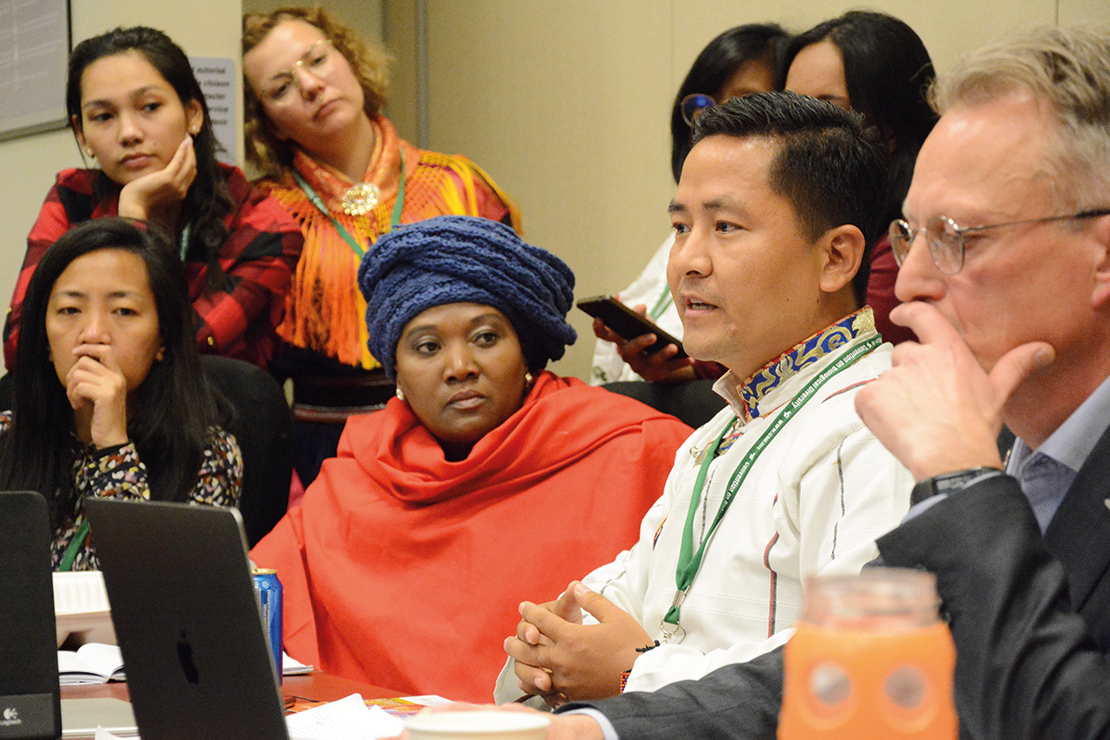
Target 19: Sharing information and knowledge
By 2020, knowledge, the science base and technologies relating to biodiversity, its values, functioning, status and trends, and the consequences of its loss, are improved, widely shared and transferred, and applied.
Key messages
- Increased collaboration between governments, scientists and IPLCs has strengthened our overall knowledge base about biodiversity values, functions, status and trends, and revealed new policy options relating to biodiversity.
- There is a wide gap between the increased recognition of the value of traditional knowledge in global policy and its continuing neglect and erosion on the ground.
- Bridging diverse knowledge systems at different scales and applying indicators relevant for IPLCs require a fundamental change in programming, funding and capacity building.
Significance of Target 19 for IPLCs
Among the ground-breaking advances in recent years has been the inclusion of indigenous and local knowledge alongside the sciences as complementary systems of knowledge for achieving fuller and richer understanding of biodiversity values, functioning, status and trends, and of the consequences of its loss at different scales. As stated by the Scientific Advisory Board of the UN Secretary General in 20161:
“Cultural diversity as a creative source and enabler for sustainable development… Diverse knowledge systems, encompassing the physical and natural sciences, social sciences and humanities, as well as indigenous and local knowledge systems are all critically important for understanding and addressing complex challenges and opportunities for people and planet. Inasmuch as biological diversity underpins the resilience of ecosystems, likewise, cultural diversity underpins social resilience for sustainable development… Rather than implying an abandonment of tradition, modernity should be tested and made sustainable in the light of cultural knowledge and values.”
One example of the emerging importance placed on indigenous and local knowledge systems is the recent global assessment by the IPBES (See Box 43).
Box 43: Eduardo S. Brondizio (Indiana University Bloomington; Co-chair, IPBES Global Assessment on Biodiversity and Ecosystem Services), on behalf of the co-chairs, technical support units, and authors of the IPBES Global Assessment
Members of IIFB participate in a meeting of the CBD Working Group on Article 8( j) and related provisions in Montreal, November 2019. Credit: Tom Dixon.

Case study: Science and indigenous and local knowledge have complemented and enriched each other throughout the IPBES global assessment process
It was clear that fulfilling the mandate of the IPBES Global Assessment on Biodiversity and Ecosystem Services would require a comprehensive, multi-faceted approach to incorporate, synthesise and scale up the contributions of indigenous and local knowledge, practices, and innovations and issues concerning indigenous peoples and local communities (IPLCs), from local to global levels. Evidence shows that, while indigenous and local knowledge systems are locally based, they are manifested in regional landscapes and ecosystems, and are globally relevant.
— Read the full case study

A botanist interviews indigenous Australians. Credit: Bill Bachman.
Contributions and experiences of IPLCs towards Target 19
Community-based monitoring and information systems
Community-based monitoring and information systems (CBMIS) using indicators relevant for indigenous peoples have become more widespread in recent years2, as their importance for self-governance has become better understood, and as the monitoring of governments and business for their compliance with global obligations and commitments has been stepped up.
CBMI face many challenges in bridging data collection between local and global scales. While they uphold community-based monitoring for local governance and use indicators and approaches relevant for community needs, the data generated can also contribute to national and global reporting and thematic assessments. In the words of the UN Statistics Division: “Data collection and dis-aggregation concerning indigenous peoples pose unique challenges in terms both of developing data for global comparative purposes and of developing data that is useful at a micro-level for indigenous peoples.”3 In the context of adopting indicators for the SDGs, the approach of promoting an “ecosystem of data”—including official statistics and the contributions of multiple actors through, for example, citizen science and community-based monitoring—seeks to ensure the best possible evidence-base for policy decisions about the future of people and planet.
Indigenous peoples have also been active in established self-driven and self-directed platforms to enhance knowledge-sharing in global policy processes. A selection of key indigenous-led platforms and caucuses is provided in Box 44.
Box 44
Global policy platforms and learning networks of indigenous peoples and local communities
IPLC organisations and networks work together on several global platforms to monitor progress on the implementation of the global agenda on sustainable development, biodiversity and climate change, some examples of which are described below. CBMIS-generated data informs policy advice and engagement with governments and other actors, thus linking grassroots realities with national reporting and global assessment and reviews.
The International Indigenous Forum on Biodiversity and the CBD
The International Indigenous Forum on Biodiversity collaborates with the Indigenous Women’s Biodiversity Network, the Centres of Distinction on Indigenous and Local Knowledge, the Forest Peoples Programme, and the Secretariat of the CBD to produce Local Biodiversity Outlooks as a complementary publication to the Global Biodiversity Outlooks.
The International Indigenous Forum on Biodiversity and Ecosystem Services and the network of Centres of Distinction on Indigenous and Local Knowledge; and IPBES
Comprised of organisations implementing programmes on indigenous and local knowledge in different global regions, these networks identify and link the holders of indigenous and local knowledge with experts in geographic regions or themes, creating focal points for collaborative work with each other and with governments, scientists, researchers and policy specialists.
The Indigenous Peoples Major Group for Sustainable Development and the UN Sustainable Development Goals
The Indigenous Peoples Major Group for Sustainable Development (IPMG)4 has published regional reports and a global report on the situation of lands, territories and resources of indigenous peoples; thematic reports on biodiversity, on indicators, on access to energy and on inclusion, equality and empowerment; and a special report on indigenous women. IPMG supports the Indigenous Navigator5, a shared CBMIS framework for monitoring implementation of: the UN Declaration on the Right of Indigenous Peoples; the SDGs; and the outcomes of the 2014 World Conference on Indigenous Peoples being implemented in 11 countries (Nepal, Bangladesh, Philippines, Cambodia, Colombia, Peru, Suriname, Cameroon, Kenya and Tanzania) and funded by the European Commission.
The International Indigenous Peoples Forum on Climate Change and the UNFCCC
The International Indigenous Peoples Forum on Climate Change has successfully advocated for environmental and social safeguards in REDD+ and the creation of a ‘local communities and indigenous peoples platform’ to strengthen the knowledge, technologies, practices and efforts of local communities and indigenous peoples in relation to climate change. A facilitative working group has been established to elaborate the work programme and to further operationalise the platform.
The International Indigenous Peoples’ Forum on World Heritage
The International Indigenous Peoples’ Forum on World Heritage6 was created by indigenous delegates at the 41st session of the UNESCO World Heritage Committee in Krakow, Poland, in July 2017. Modelled on the CBD and the UN Framework Convention on Climate Change, it is a standing global body aiming to engage with the World Heritage Committee during its meetings, to represent the voices of indigenous peoples on the World Heritage Convention.
Remaining barriers
Despite important advances, an implementation gap continues to exist between the global and local recognition of the importance of indigenous and local knowledge. Globally, it is recognised in contemporary problem-solving, but in national policies and strategies it continues to be neglected and lacks protection. The numerous good examples highlighting progress in recognising indigenous and local knowledge and its contributions should not overshadow the underlying social marginalisation faced by indigenous peoples and local communities in most countries, which curtails their agency and voice in national decision-making, planning and implementation of the agenda for global transformation.
The recent IPBES Global Assessment on Biodiversity and Ecosystem Services shows the importance of evidence-based assessments of the full contributions of IPLC collective actions to the conservation and sustainable use of biodiversity and to all the Aichi Biodiversity Targets. Community-based monitoring and information is an innovative contribution complementing global data and information on indigenous peoples, but indigenous peoples still face huge and growing inequalities in accessing data and information technologies, and in their ability to use them to manage the risks of their private or sacred knowledge being misappropriated and misused.7
Opportunities and recommended actions
Governments, IPLCs, UN bodies (including the Inter-Agency Support Group on Indigenous Peoples’ Issues), scientific bodies, academia and funders should:
- Strengthen partnerships to improve the sharing of information and technologies on indigenous and local knowledge;
- Strengthen synergies and holistic approaches among IPLC knowledge platforms engaging biodiversity, sustainable development and climate change processes, and move towards strategic partnerships on monitoring relevant indigenous and local knowledge indicators at local, national and global scales;
- Increase institutional and financial support for building capacity in, and using, CBMIS for generating, storing, managing and using data and information through, for example, giving IPLCs greater access, control and management of information and communication technologies;
- Strengthen interfaces between global, national, and community-based processes of data and knowledge generation; and strengthen the use of relevant indigenous and local knowledge indicators that data platforms and statistical bodies use for monitoring and reporting, including disaggregating data on the status of indigenous peoples, women, youth and marginalised groups;
- Document, disseminate and apply lessons from successful collaborations across diverse knowledge systems, such as IPBES, the ‘International Partnership for the Satoyama Initiative’, Multiple Evidence Base approach, evidence-based partnerships and community-based natural resource management groups;
- Mainstream training on the complementarity of sciences, technologies and indigenous and local knowledge for biodiversity conservationists, natural resource scientists, and academics in other disciplines.
Key resources
- Scientific Advisory Board of the Secretary-General of the United Nations (2016) ‘Indigenous and local knowledge(s) and science(s) for sustainable development: policy brief by the Scientific Advisory Board of the UN Secretary-General’. SC/2016/UNSAB/ILK. Scientific Advisory Board of the Secretary-General of the United Nations. Available at: https://unesdoc.unesco.org/ark:/48223/pf0000246104
- Tebtebba (2018) Enhancing indigenous peoples development through community-based monitoring and information systems (CBMIS). Baguio: Tebtebba. Available at: https://www.tebtebba.org/index.php/resources-menu/publications-menu/books/60-enhancing-indigenous-peoples-development-through-cbmis
- IPBES (2017) ‘Approach to recognizing and working with indigenous and local knowledge in the Intergovernmental Science-Policy Platform on Biodiversity and Ecosystem Services’. Annex II to decision IPBES-5/1 in Report of the Plenary of the Intergovernmental Science-Policy Platform on Biodiversity and Ecosystem Services on the work of its fifth session. IPBES/5/15. Available at: https://ipbes.net/sites/default/files/inline/files/ipbes_ilkapproach_ipbes-5-15.pdf
- Action Group on Knowledge Systems and Indicators of Wellbeing (n.d.) ‘Nature-Culture Indicators and Knowledge Systems Resource Directory’. Center for Biodiversity and Conservation, American Museum of Natural History. Available at: http://resources.cbc.amnh.org/indicators/about.html
References
- Scientific Advisory Board of the Secretary-General of the United Nations (2016). Indigenous and local knowledge(s) and science(s) for sustainable development: policy brief by the Scientific Advisory Board of the UN Secretary-General. SC/2016/UNSAB/ILK. Scientific Advisory Board of the Secretary-General of the United Nations. Available at: https://unesdoc.unesco.org/ark:/48223/pf0000246104
- Tebtebba (2018) Enhancing Indigenous Peoples Development through Community-Based Monitoring and Information Systems (CBMIS). Baguio: Tebtebba. Available at: https://www.tebtebba.org/index.php/resources-menu/publications-menu/books/60-enhancing-indigenous-peoples-development-through-cbmis
- United Nations Economic and Social Council (2004) Report of the workshop on data collection and disaggregation for indigenous peoples. E/C.19/2004/2 [11]: 10 (10 February 2004). Available at: https://digitallibrary.un.org/record/517063?ln=en
- Indigenous Peoples Major Group for Sustainable Development: https://indigenouspeoples-sdg.org/index.php/english/
- Indigenous Navigator: http://nav.indigenousnavigator.com/index.php/en/
- International Indigenous Peoples’ Forum on World Heritage: https://iipfwh.org/
- Vesper, I. (2016) ‘Indigenous people need control over digital tech’. Oxford: SciDevNet. Available at: https://www.scidev.net/global/indigenous/news/indigenous-peopl-control-digital-tech.html


